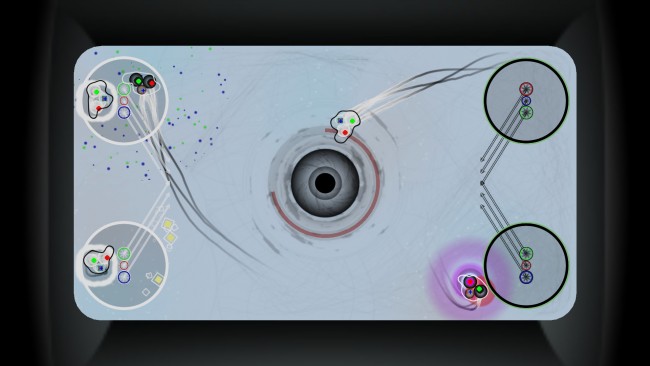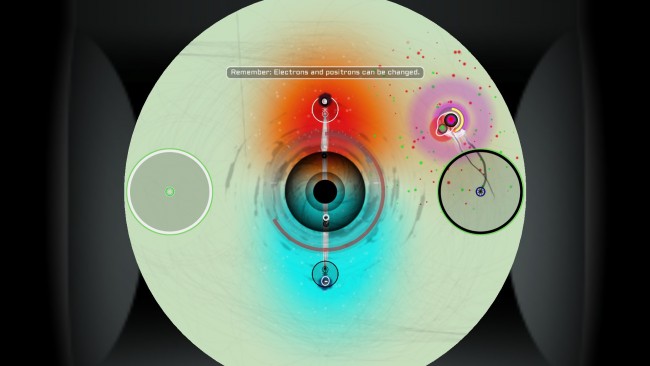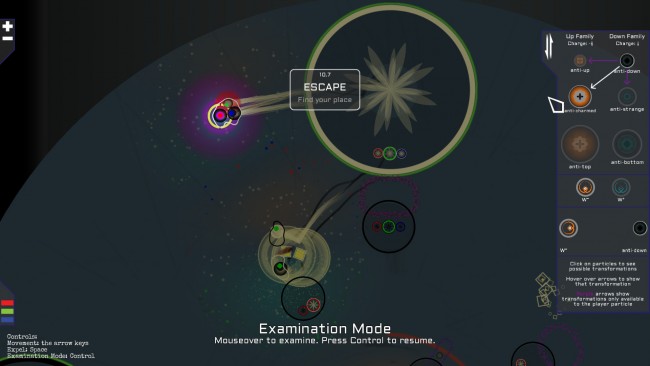
Quantum physics is weird. There’s a lot of particles interacting and annihilating with one another because of forces that scientifically make sense, but piecing it all together to fully grasp any of what’s happening can be mind-destroying. If you go to a textbook or a Wikipedia article, you need to be a savant or a Ph.D. candidate to understand what’s going on. Enter Particulars, a game based on the standard model of particle physics that’s better at showing subatomic interactions than any $300 textbook from uni. And before you go thinking this is thinly veiled edutainment with an agenda for teaching, oh no, it’s a game first and foremost, and what a game it is.
You might be wondering just how a game can coalesce from models of subatomic particles, but it’s more intuitive than you’d think. You play as a quark, one of the fundamental particles of the standard model, floating around in a vacuum with other subatomic particles. Each particle has a mass, charge, and other characteristics that attract or repel you, and depending on what kind of particle it is, it’ll annihilate the hell out of you. Levels consist of pushing particles into a certain position or creating a particular kind of particle (which can be trickier than it sounds… Or just as tricky). Floating around feels like swimming in a pool with currents pushing you, but this is just half of the challenge.

Originally, you are a down quark and just a down quark, but everything changes halfway through the game. You are able to force yourself to decay (complete with boson emission) to an up quark, absorb bosons to become strange, charm, top, or down quarks, and force other particles to undergo similar transformations. The platforming puzzles take on a new complexity and require more thought than spawning billions more particles like a Large Hadron Collider operator with time to kill. The later chapters of the game even integrate the nuclear strong force into the game that spice things up yet again, but the levels do not follow suite.
For the first half of the game, the level design and pacing are fantastic. New forces are introduced and exploited by the layout of the level in nifty ways. The problem is that at the halfway point of the game, the levels are just reused from the first half in the same order. There are new forces in play and your ability to decay changes how you view the levels, but reusing every level from the first half feels like a cop out. The game is pretty short too (~4-6 hours), so it leaves you wanting much more. This mid-game flip mimics the less than incredible story.

The main plot of the game revolves around a troubled young physicist named Allison. As it would just so happen, Allison has constructed a bubble universe in an arcade machine as an escape from the traumatic events in her life (and become a bit of a hermit). These events are unveiled through quotes from friends and colleagues read out like snippets from a textbook between levels, as well as animated cutscenes between chapters. The storytelling flips mid-game when the story’s conspiracy turns into Allison’s reality that she has to deal with, which would be fine if it wasn’t angstier than Neil Bohr in his moody years.
Every piece of narrative in the game reeks of a desire to be taken seriously. From the voice acting to the cutscene’s art style, the plot seems more preoccupied with being seen as legitimate than being genuinely compelling. It gets the job done as far as narratives go, but it’s constant dreariness and cliché developments make it a less than thrilling experience. There are some nice parts where the game mechanics tie into the narrative (making a black hole bigger because Allison is digging herself deeper into a hole), but Particulars is carried by it’s gameplay.

While the story plays out like a high school potato experiment by a teacher with an emo fringe, the game itself controls well and looks fantastic. Controlling your particle is simply a matter of going up down left or right, but controlling your particle involves knowing what’s happening around you. Despite the complexity of the game mechanics, you are never bombarded with too much visual information, so knowing what’s happening is easy to pick up on and manoeuvre around. This is done through a minimal UI layout and a helpful examination mode that explains the forces and decay patterns in play.
Perhaps the most outstanding feature of the game is that it somehow makes quantum physics accessible. In examination mode, you can identify particles on the screen by clicking on them. Doing so brings up information about them and (if you’re willing) a brief explanation of their place in the standard model scientists use today. You’re not pressured to learn much beyond how attraction and repulsion work with different looking balls, but if you’re willing to dig deeper, you’re more than welcome.

 Fantastic concept
Fantastic concept
 Nifty level design
Nifty level design
 Accessible complexity
Accessible complexity
 Good looking
Good looking
 Lackluster story
Lackluster story
 Reuses levels
Reuses levels
While it’s not going to turn you into a particle physicist anytime soon, Particulars is a game that might just pique your interest in the field. Regardless of its subject matter, the game is a fun if somewhat short puzzle platformer that’s certainly worth a look. It might be bogged down by excessive melodrama, but the gameplay more than makes up for it. You wouldn’t think a game about particle physics would be fun, but I can assure you that Particulars is. Doesn’t make quantum physics any less weird though.











